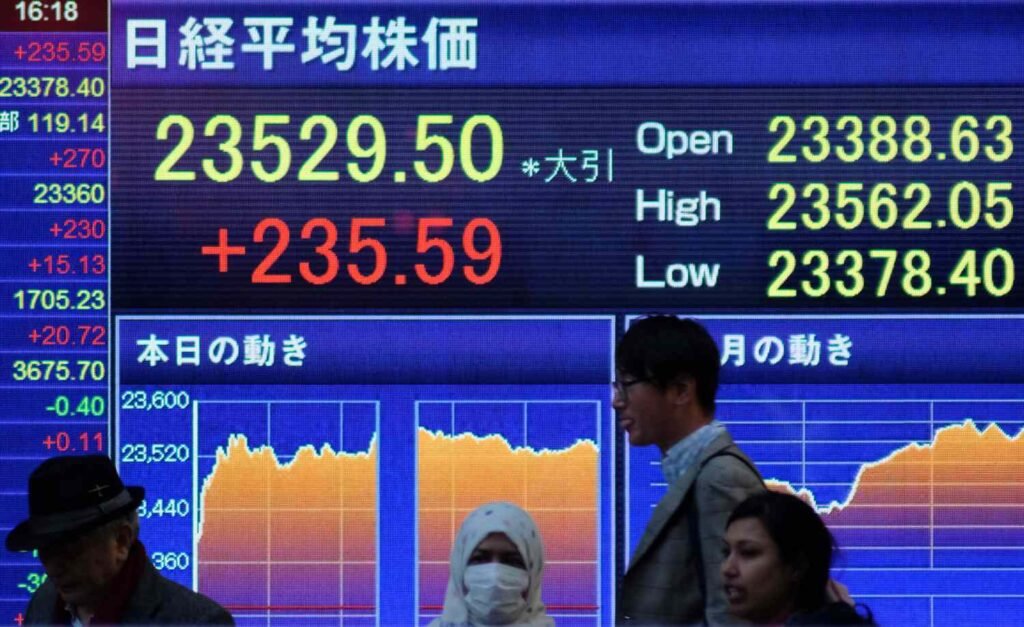:max_bytes(150000):strip_icc():format(jpeg)/WeakFormEfficiency-198021115837419c889db18e902c2737.jpg)
Japan’s Nikkei 225 stock market index did something many investors thought improbable: It finally surpassed the late-1980s peak reached during the country’s massive asset bubble. Though it has since retreated, some analysts predict big gains again in 2025.
Most of those predictions came before Trump announced a flurry of tariffs, including on Japanese exports. However, Japanese shares still trade at a meaningful discount when compared to the S&P 500, even as profit margins and dividends improve. For U.S. investors looking to diversify, Japanese equities may finally deserve a closer look.
Why Japan Looks Different This Time
Japan’s so-called “lost decades” after 1990 scarred an entire generation of investors, but the narrative seems to have quietly shifted.
Reforms that began in 2010’s “Abenomics” era—lower corporate taxes, a revamped stewardship code, and the Tokyo Stock Exchange’s ongoing campaign to shame chronically low‑return companies—appear to be bearing fruit. Shareholder dissent in board elections is at record levels, forcing managers to focus on profits and payouts.
Even after the gains of recent years, the index trades around 15–16 times forward earnings, versus 25x-30x for the S&P 500. Dividend yields hover near 2%—low in absolute terms but a sea change for historically stingy Japan.
Three Catalysts Driving Returns
- A weak currency boosts exporters. The yen averaged around ¥150 per dollar in 2024, its softest level since the mid‑1980s, inflating overseas profits when repatriated. While the Bank of Japan has started a slow exit from negative rates, its policy remains looser than the Fed’s, suggesting the currency may stay subdued.
- Governance and activism get teeth. Japan’s new rules push companies trading below book value to articulate improvement plans or face naming and shaming by the exchange. Activist campaigns and buybacks are already accelerating.
- Warren Buffett’s stamp of approval. Berkshire Hathaway has lifted stakes in the five “sōgō shōsha” trading houses to about 10% each, with Buffett saying he could hold them “for 50 years.” His endorsement has drawn fresh attention from American investors.
Risks to Watch
Tariffs, policy shifts, and slowing growth could offset Japan’s tailwinds.
Trump’s trade plan, which includes a 24% car levy and a 10% blanket tariff on Japanese exports, threatens margins, with automakers warning that billions in profits are at risk.
The tariff standoff also filters into Bank of Japan deliberations, with policymakers split on whether U.S. protectionism will force rate hikes, risking a stronger yen and higher domestic costs. Japan’s GDP unexpectedly contracted 0.2% in the first quarter of 2025, before the tariff hit, thanks to softer exports and stubbornly weak real wages. A prolonged trade spat could deepen that slowdown, especially if consumer sentiment weakens.
Three Practical Paths for U.S. Investors: ETFs, ADRs, and Direct Shares
- Japan ETFs. The iShares MSCI Japan ETF (EWJ) offers plain‑vanilla exposure, while currency‑hedged Japan ETFs such as WisdomTree’s DXJ and iShares’ HEWJ strip out the yen’s swings—helpful if you expect further depreciation. Dividend‑focused, small‑cap, or value‑tilted Japan funds let you express specific themes at lower cost than buying dozens of stocks; for example WisdomTree Japan Hedged SmallCap Equity Fund (DXJS) or iShares MSCI Japan Value ETF (EWJV).
- ADRs. More than 50 Japanese companies, from Toyota (TM) and Nissan (NSANY) to Nintendo (NTDOY) and Sony (SONY), trade as American Depositary Receipts, or ADRs, on U.S. exchanges.
- Direct Access. Some full‑service brokers like Fidelity, Morgan Stanley, and Interactive Brokers let U.S. residents buy and hold Tokyo‑listed shares directly and may even participate in shareholder perks known as yūtai.
Important
Owning unhedged Japan funds gives you currency risk exposure: if the yen falls, stock gains may be offset when translated back to dollars. Hedged ETFs solve that, but they’ll underperform if the yen rebounds. A 50/50 split between hedged and unhedged is a common compromise.
Bottom Line
After decades of disappointment, Japanese equities are enjoying a revival driven by shareholder‑friendly reforms, a competitive currency, and interest from institutional investors. Valuations remain reasonable, and the market adds geographic, sectoral, and currency diversification to a U.S.‑heavy portfolio—although tariffs could put a damper on things.
Japan may never be “cheap” again, but it still looks early in a story that is finally getting interesting.

